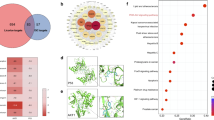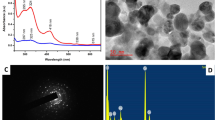Abstract
The present study was undertaken to investigate whether RP-1 treatment protected mitochondrial system against radiation damage and also to unravel the mechanism associated with this process. Radioprotection of mitochondrial system by Podophyllum hexandrum (RP-1) was investigated to understand its mechanism of action. Levels of superoxide anion (O2−), reduced or oxidized glutathione (GSH or GSSG), thiobarbituric acid reactive substance (TBARS), protein carbonyl (PC), ATP, NADH-ubiquinone oxidoreductase (complex-I), NADH-cytochrome c oxidoreductase (complex I/II), succinate-cytochrome c oxidoreductase (complex II/III) and mitochondrial membrane potential (MMP) were studied in mitochondria isolated from liver of mice belonging to various treatment groups. Whole body γ-irradiation (10 Gy) significantly (p < 0.01) increased the formation of O2−, PC, and TBARS, upto 24 h as compared to untreated control. RP-1 treatment (200 mg/kg b.w.) to mice 2 h before irradiation reduced the radiation-induced O2− generation within 4 h and formation of TBARS and PC upto 24 h significantly (p < 0.01). Singularly irradiation or RP-1 treatment significantly (p < 0.01) increased the levels of glutathione within an hour, as compared to untreated control. Pre-irradiation administration of RP-1 enhanced levels of GSH induced increase in complex I (upto 16 h), complex I/III (4 h) complex II/III activity (upto 24 h;p < 0.01) and inhibited the radiation-induced decrease in MMP significantly (24 h;p < 0.01). The present study indicates that RP-1 itself modulates several mitichondrial perameters due to its influence on the biochemical milieu within and outside the cells. However, RP-1 treatment before irradiation modulates radiation induced perturbations such as the increase in electron transport chain enzyme activity, formation of O2−, TBARS and PC to offer radioprotection (Mol Cell Biochem 266: 65–77, 2004)
Similar content being viewed by others
References
Cai J, Jonas DA: Superoxide in apoptosis. J Biol Chem 273: 11401–11404, 1998
Ferri KF, Kroemer G: Mitochondria-the suicide organelles. BioEssays 23: 111–115, 2001
Wallace DC: Mitochondrial diseases in man and mouse. Science 283: 1482–1488, 1999
Somosy Z: Radiation response of cell organelles. Micron 31: 165–181, 2000
Rafique R, Schapira AHV, Cooper JM: Sensitivity of respiratory chain activities to lipid peroxidation: effect of vitamin E deficiency. Biochem J 357: 887–892, 2001
Singh KK (ed): Mitochondrial DNA mutations in aging, disease and cancer. Springer-Verlag Berlin Heidelberg, New York, 1998
Kamat JP, Boloor KK, Devasagayam TP, Jayashree B, Kesavan PC: Differential modification by caffeine of oxygen-dependent and independent effects of gamma irradiation on rat liver mitochondria. Int J Radiat Biol 76: 1281–1288, 2000
Yang B, Kotani A, Arai K, Kusu F: Estimation of the antioxidant activities of flavonoids from their oxidation potentials. Anal Sci 17: 599–604, 2001
Boloor KK, Kamat JP, Devasagayam TP: Chlorophyllin as a protector of mitochondrial membranes against gamma-radiation and photosensitization. Toxicol 155: 63–71, 2000
Kamat JP, Boloor KK, Devasagayam TP, Venkatachalam SR: Antioxidant properties of Asparagus racemosus against damage induced by gamma-radiation in rat liver mitochondria. J Ethnopharmacol 71: 425–435, 2000
Goel HC, Prem Kumar I, Samanta N, Rana SVS: Inductions of DNA-protein cross-links by Hippophae rhamnoides: Implications in radio-protection and cytotoxicity. Mol Cell Biochem 45: 57–67, 2002
Prem Kumar I, Samanta N and Goel HC: Modulation of chromatin or-ganization by RH-3, a preparation of Hippophae rhamnoides, a possible role in radioprotection. Mol Cell Biochem 239: 1–9, 2002
Gupta D, Arora R, Garg AP, Goel HC: Radiation protection of HepG2 cells by Podophyllum hexandrum Royale. Mol Cell Biochem 250: 27–40, 2003
Samanta N, Goel HC. Protection against radiation induced damage to spermatogenesis by Podophyllum hexandrum. JEthnopharmacol 81: 217–224, 2002
Singh J, Shah NC: Podophyllum: A Review. Curr Res Med Arom Pl 16: 53–83, 1994
Wong SK, Tsui SK, Kwan SY, Su XL, Lin RC: Identification and characterization of Podophyllum emodi by API-LC/MS/MS. J Mass Spectrom 35: 1246–1251, 2000
Goel HC, Prasad J, Sharma AK:Protective effect of Podophyllum against radiation damage. Adv Radiat Biol Peace 27–32, 1999
Prem Kumar I, Goel HC: Iron chelation and related properties of Podophyllum hexandrum, a possible role in radioprotection. Indian J Exp Biol 38: 1003–1006, 2000
Mittal A, Pathania V, Agrawala PK, Parsad J, Singh S, Goel HC: Influence of Podophyllum hexandrum exposed on endogenous antioxidants defence system in mice: possible role in radioprotection. J Ethnopharmacol 76: 253–262, 2001
Salin CA, Samanta N, Goel HC: Protection of mouse jejunum against lethal irradiation by Podophyllum hexandrum.Phytomed 8: 413–422, 2001
Rickwood D, Wilson MT, Darley-Usmar, VM: Isolation and characteristics of intact mitochondria. In: V.M. Darley-Usmar, D. Rickwood, M.T. Wilson (eds). Mitochondria: A Practical Approach. I.R.L. Press, Washington, D.C. 1987, pp 4–5
Madesh M, Balasubramanian KA: A microtiter plate assay for superoxide using MTT reduction method. Indian J Bichem Biophys 34: 535–539, 1997
Hissin PJ, Hilf R: A fluorometric method for determination of oxidized and reduced glutathione in tissues. Anal Biochem 74: 214–226, 1976
Kwong K, Sohal RS: Age-related changes in activities of mitochondrial electron transport complexes in various tissues of the mouse. Arch Biochem Biophys 307: 16–22, 2000
Emaus RK, Gurnwald R, Lemasters JJ: Rhodamine 123 as a probe of transmembrane potential in isolated rat liver mitochondria: Spectral and metabolic properties. Biochem Biophys Acta 850: 436–448, 1986
Buege JA, Aust SD: Laboratory techniques in biochemistry and molecular biology. In: Burdon R.H. and Knippenberg P.H.V. (eds). Elsevier Amsterdam. 1991, pp 148–148
Schild I, Reinheckel T, Wiswedel I, Augustin W: Short-term impairment of energy production in isolated rat liver mitochondria by hypoxia/reoxygenation: involvement of oxidative protein modification. Biochem J 328: 205–210, 1997
Lowry OH, Rosenbrough NJ, Farr AL, Randall RJ: Protein measurement with Folin-Phenol reagent. J Biol Chem 193: 265, 1952
Han D, William E, Cadenas E: Mitochondrial respiratory chain-dependent generation of superoxide anion and release into the inter-membrane space. Biochem J 353: 411–416, 2001
Konings AWT, Drijver EB: Radiation effects on membranes I. vitamin E deficiency and lipid peroxidation. Radiat Res 80: 494–501, 1979
Kergonou JF, Braquet M, Rocquet G: Influence of whole body γ-irradiation upon rat liver mitochondrial fractions. Radiat Res 88: 377–384, 1981
Lu SC: Regulation of hepatic glutathione synthesis: current concepts and controversies. FASEB 13: 1169–1183, 1999
Fahey RC: Protection of DNA by thiols. Pharmacol Ther 39: 101–108, 1988.
Scahfer FQ, Buettner GR: Redox environment of the cell as viewed through the redox state of the glutathione disulfide/glutathione couple. Free Radic Biol Med 30: 1191–1212, 2001
Griffith WO, Meister A: Origin and turnover of mitochondrial glutathione. Proc Natl Acad Sci USA 82: 4668–4672, 1985
Middleton E, Kandaswamy C, Theiharidies TC: The effects of plant flavonoids on mammalian cells: Implications for inflammation, heart disease, and cancer. Pharmacol Rev 52: 673–751, 2000
Myhrstad MC, Carlsen H, Nordstrom O, Blomhoff R, Moskaug JJO: Flavonoids increase the intracellular glutathione level by transactivation of gamma-glutamylcysteine synthetase catalytical subunit promoter. Free Radic Biol Med 32: 386–393, 2002
Saraste M: Oxidative phosphorylation at the fin de siecle. Science 283: 1488–1492, 1999
Heuvel LVD, Smeitink J: The oxidative phosphorylation (OXPHOS) system: nuclear genes and human genetic diseases. BioEssays 23: 518–525, 2001.
Jha N, Jurma O, Lalli G, Liu Y, Pettus EH, Greenamyre JT, Liu RM, Forman HJ, Andersen JK: Glutathione depletion in PC12 results in selective inhibition of mitochondrial complex I activity. J Biol Chem 275: 26096–26101, 2000
Zhang Y, Marcillant O, Giulivi C, Ernster L, Davis KJA: The oxidative inactivation of mitochondrial electron transport chain components and ATPase. J Biol Chem 265: 16330–16336, 1990
Shigenaga MK, Hagen TM, Ames BN: Oxidative damage and mitochondrial decay in aging. Proc Natl Acad Sci. USA 91: 10771–10778, 1994
Biaglow JE, Varnes ME: The role of thiols in cellular response to radiation and drugs. Radiat Res 95: 437–455, 1983
Author information
Authors and Affiliations
Rights and permissions
About this article
Cite this article
Gupta, D., Arora, R., Garg, A.P. et al. Modification of radiation damage to mitochondrial system in vivo by Podophyllum hexandrum: Mechanistic aspects. Mol Cell Biochem 266, 65–77 (2004). https://doi.org/10.1023/B:MCBI.0000049139.05337.40
Issue Date:
DOI: https://doi.org/10.1023/B:MCBI.0000049139.05337.40




